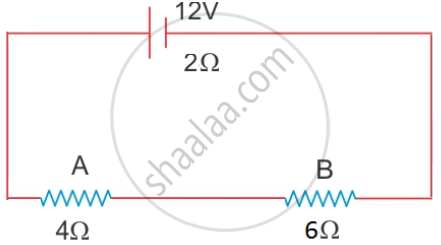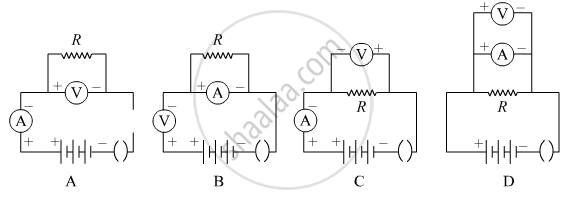Advertisements
Advertisements
प्रश्न
A battery of emf 12 V and internal resistance 2 Ω is connected with two resistors A and B of resistance 4 Ω and 6 Ω respectively joined in series.

Find:
1) Current in the circuit
2) The terminal voltage of the cell
3) The potential difference across 6Ω Resistor
4) Electrical energy spent per minute in the 4Ω resistor.
उत्तर
E = 12 V; ri = 2 Ω; RA = 4 Ω; RB = 6 Ω
1) The current in the circuit is
`I = E/R_"total" = E/(r_i + r_A + r_B)`
`:. I = 12/(2+4+6) = 1 A`
2) The terminal voltage of the cell is
V = E - Iri
∴ V = 12 - (1 x 2) = 12 - 2 = 10 V
3) The potential difference across the 6 Ω is
VB = IRB
∴ VB = 1 x 6 = 6V
4) The electrical energy spent per minute (=60 s) is
E = I2Rt
E = 12 X 4 X 60 = 240J
APPEARS IN
संबंधित प्रश्न
A current of 200 mA flows through a 4 kΩ resistor. What is the p.d. across the resistor?
In the circuit shown below:

The potential difference across the 3 Ω resistor is:
Explain the statement ‘the potential difference between two points is 1 volt’.
Explain the analogy between the flow of charge (or current) in a conductor under a potential difference with the free fall of a body under gravity.
The following table shows current in Amperes and potential difference in Volts.
Which law will the graph prove? Explain the law.

Which one of the following is the correct set-up for studying the dependence of the current on the potential difference across a resistor and why?

An electric charge always flows from a point at a ______ to a point at a ______.
What does the positive and negative sign of potential convey?
Find the potential difference required to flow a current of 300 mA in a wire of resistance 20 Ω.
